Iran’s first direct attack on Israel overnight Saturday demonstrated the country’s military might and the advances of its domestic weapons program, analysts said, while also revealing the limitations of its arsenal.
What Iran’s attack on Israel revealed about its weapons arsenal
“The operation showed that our armed forces are ready,” Iranian president Ebrahim Raisi told crowds gathered Wednesday in Tehran to mark Army Day. Parades in the Iranian capital featured many of the same munitions used in the attack on Israel.

What Iran used against Israel
170 drones
110 ballistic
missiles
30 cruise
missiles
Iranian drones
These drones can deliver small payloads of explosives in self-detonating attacks.
SHAHED-136
Length: 11.5 ft.
Width: 8 ft.
Max. take off weight: 440 lb.
Max. speed: 115 mph
Range: About 1,100 - 1,500 miles
Its nose contains a warhead and can be equipped with a camera.
SHAHED-131
Length: 8 ft.
Width: 7 ft.
Max. take off weight: 300 lb.
The Shahed-131 is an earlier version of Shahed-136 with a similar principle of operation. The layout and aerodynamics are also identical.
Ballistic missiles
KHEIBAR SHEKAN
The Kheibar Shekan MRBM is a solid-propellant ballistic missile designed by the IRGC.
Length: 34 ft.
Diameter: 2.6 ft.
Max. range: 900 miles
Warhead weight: 1,100 lb.
Introduction: 2022
EMAD
The Emad MRBM is an Iranian-designed, liquid-fuel ballistic missile based on Shahab-3.
Length: 54 ft.
Diameter: 4.1 ft.
Max. range: 1,056 miles
Warhead weight: 1,650 lb.
Introduction: 2015
GHADR
The Ghadr-1 MRBM seems to be an improved variant of the Shahab-3A. It is also referred to as the Ghadr-101 and the Ghadr-110.
Length: 54 ft.
Diameter: 4.1 ft.
Max. range: 1,211 miles
Warhead weight: 1,760 lb.
Introduction: 2007
Cruise missile
PAVEH
Max. range: 1,025 miles
Introduction: 2023
What Iran did not use
SEJJIL-1
The Sejjil-1 Iranian MRBM is a two-stage, solid-propellant, surface-to-surface missile.
Length: 60 ft
Diameter: 4.1 ft.
Max. range: 1,243 miles
Warhead weight: 1,540 lb.
Introduction: 2011
SHAHAB-3
The Shahab-3 is a MRBM developed by Iran and based on the North Korean Nodong-1.
Length: 54 ft.
Diameter: 4.1 or 4.5 ft.
Max. range: 808 miles
Warhead: Single or multiple
with 5 warheads of 617 lb.
Introduction: 2003
Sources: OE Data Integration Network (ODIN),
CSIS Missile Defense Project

What Iran used against Israel
170 drones
120 ballistic
missiles
30 cruise
missiles
Iranian drones
These drones can deliver small payloads of explosives in self-detonating attacks.
SHAHED-136
Length: 11.5 ft.
Width: 8 ft.
Max. take off weight: 440 lb.
Max. speed: 115 mph
Range: About 1,100 - 1,500 miles
Its nose contains a warhead and can be equipped with a camera.
SHAHED-131
Length: 8 ft.
Width: 7 ft.
Max. take off weight: 300 lb.
The Shahed-131 is an earlier version of Shahed-136 with a similar principle of operation. The layout and aerodynamics are also identical.
Ballistic missiles
KHEIBAR SHEKAN
The Kheibar Shekan MRBM is a solid-propellant ballistic missile designed by the IRGC.
Length: 34 ft.
Diameter: 2.6 ft.
Max. range: 900 miles
Warhead weight: 1,100 lb.
Introduction: 2022
EMAD
The Emad MRBM is an Iranian-designed, liquid-fuel ballistic missile based on Shahab-3.
Length: 54 ft.
Diameter: 4.1 ft.
Max. range: 1,056 miles
Warhead weight: 1,650 lb.
Introduction: 2015
GHADR
The Ghadr-1 MRBM seems to be an improved variant of the Shahab-3A. It is also referred to as the Ghadr-101 and the Ghadr-110.
Length: 54 ft.
Diameter: 4.1 ft.
Max. range: 1,211 miles
Warhead weight: 1,760 lb.
Introduction: 2007
Cruise missile
PAVEH
Max. range: 1,025 miles
Introduction: 2023
What Iran did not use
SEJJIL-1
The Sejjil-1 Iranian MRBM is a two-stage, solid-propellant, surface-to-surface missile.
Length: 60 ft
Diameter: 4.1 ft.
Max. range: 1,243 miles
Warhead weight: 1,540 lb.
Introduction: 2011
SHAHAB-3
The Shahab-3 is a MRBM developed by Iran and based on the North Korean Nodong-1.
Length: 54 ft.
Diameter: 4.1 or 4.5 ft.
Max. range: 808 miles
Warhead: Single or multiple
with 5 warheads of 617 lb.
Introduction: 2003
Sources: OE Data Integration Network (ODIN),
CSIS Missile Defense Project

What Iran used against Israel
170 drones
120 ballistic missiles
30 cruise missiles
Iranian drones
These drones can deliver small payloads of explosives in self-detonating attacks.
SHAHED-136
Length: 11.5 ft.
Width: 8 ft.
Overhead view
Max. take off weight: 440 lb.
Max. speed: 115 mph
Range: About 1,100 - 1,500 miles
Its nose contains a warhead and can be equipped with a camera.
SHAHED-131
Length: 8 ft.
Width: 7 ft.
Max. take off weight: 300 lb.
The Shahed-131 is an earlier version of Shahed-136 with a similar principle of operation. The layout and aerodynamics are also identical.
Ballistic missiles
EMAD
GHADR
KHEIBAR SHEKAN
The Emad MRBM is an Iranian-designed, liquid-fuel ballistic missile based on Shahab-3.
The Ghadr-1 MRBM seems to be an improved variant of the Shahab-3A. It is also referred to as the Ghadr-101 and the Ghadr-110.
The Kheibar Shekan MRBM is a solid-propellant ballistic missile designed by the IRGC.
54 ft.
54 ft.
Length:
34 ft.
4.1 ft.
4.1 ft.
Diameter:
2.6 ft.
1,211 miles
1,056 miles
Max. range:
900 miles
1,760 lb.
1,650 lb.
Warhead weight:
1,100 lb.
2007
2015
Introduction:
2022
Cruise missile
PAVEH
Max. range: 1,025 miles
Introduction: 2023
What Iran did not use
SEJJIL-1
SHAHAB-3
The Sejjil-1 Iranian MRBM is a two-stage, solid-propellant, surface-to-surface missile.
The Shahab-3 is a MRBM developed by Iran and based on the North Korean Nodong-1.
Length: 60 ft
Length: 54 ft.
Diameter: 4.1 ft.
Diameter: 4.1 or 4.5 ft.
Max. range: 1,243 miles
Max. range: 808 miles
Warhead: Single or multiple
with 5 warheads of 617 lb.
Warhead weight: 1,540 lb.
Introduction: 2011
Introduction: 2003
Sources: OE Data Integration Network (ODIN), CSIS Missile Defense Project

What Iran used against Israel
170 drones
120 ballistic missiles
30 cruise missiles
Iranian drones
These drones can deliver small payloads of explosives in self-detonating attacks.
SHAHED-136
Length: 11.5 ft.
Width: 8 ft.
Overhead view
Max. take off weight: 440 lb.
Max. speed: 115 mph
Range: About 1,100 - 1,500 miles
Its nose contains a warhead and can be equipped with a camera.
SHAHED-131
Length: 8 ft.
Width: 7 ft.
Max. take off weight: 300 lb.
The Shahed-131 is an earlier version of Shahed-136 with a similar principle of operation. The layout and aerodynamics are also identical.
Cruise missile
PAVEH
Max. range: 1,025 miles
Introduction: 2023
Ballistic missiles
EMAD
GHADR
KHEIBAR SHEKAN
The Emad MRBM is an Iranian-designed, liquid-fuel ballistic missile based on Shahab-3.
The Ghadr-1 MRBM seems to be an improved variant of the Shahab-3A. It is also referred to as the Ghadr-101 and the Ghadr-110.
The Kheibar Shekan MRBM is a solid-propellant ballistic missile designed by the IRGC.
Length: 54 ft.
Length: 54 ft.
Length: 34 ft.
Diameter: 4.1 ft.
Diameter: 4.1 ft.
Diameter: 2.6 ft.
Max. range: 1,211 miles
Max. range: 1,056 miles
Max. range: 900 miles
Warhead weight: 1,760 lb.
Warhead weight: 1,650 lb.
Warhead weight: 1,100 lb.
Introduction: 2007
Introduction: 2015
Introduction: 2022
What Iran did not use
SEJJIL-1
SHAHAB-3
The Sejjil-1 Iranian MRBM is a two-stage, solid-propellant, surface-to-surface missile.
The Shahab-3 is a MRBM developed by Iran and based on the North Korean Nodong-1.
Length: 60 ft
Length: 54 ft.
Diameter: 4.1 ft.
Diameter: 4.1 or 4.5 ft.
Max. range: 1,243 miles
Max. range: 808 miles
Warhead: Single or multiple
with 5 warheads of 617 lb.
Warhead weight: 1,540 lb.
Introduction: 2011
Introduction: 2003
Sources: OE Data Integration Network (ODIN), CSIS Missile Defense Project
Raisi hailed the attack as a resounding “success,” but was also quick to qualify the strikes as “limited” and “not comprehensive.”
“If it was supposed to be a large-scale action, nothing would have been left of the Zionist regime,” he said. And if Israel retaliates, Raisi pledged, “they will be dealt with fiercely and severely.”
Yet after analyzing the munitions used in Saturday’s assault and the success of regional defense systems, researchers say it’s unclear how Iran could inflict greater damage on Israel through conventional military means.
“Iran basically threw everything it had that could reach Israel’s territory,” said John Krzyzaniak, a researcher who studies Iran’s missile programs at the Wisconsin Project on Nuclear Arms Control. Like other analysts interviewed for this story, he has spent the past several days studying launch videos, imagery of debris and interception information to identify the Iranian munitions.
His conclusion is that Tehran “used some of every system they have.” And experts said it made sense that the Sejjil-1 and Shahab-3 missiles were excluded from the attack.
Shahab-3 “wasn’t used because it’s so old,” said Fabian Hinz, an Iran analyst at the International Institute for Strategic Studies in Berlin. “The Sejjil is a bit of a mysterious missile,” he said, adding that Iran has “used it very, very little during maneuvers.”
Other analysts noted the Sejjil was expensive to produce and may no longer be in production.
The quantity of munitions used also provides new insights into Iran’s capabilities. The deployment of over 100 ballistic missiles in a single wave suggests that previous estimates that Iran has about 3,000 ballistic missiles stockpiled are probably accurate, and could even be on the low end.
“If this is just round one of an unknown number of rounds to come, you wouldn’t fire a significant fraction of what you have just in the first round,” Krzyzaniak said.
The firing of over 100 ballistic missiles in the space of a few minutes suggests Iran has at least 100 launchers, he added — a new data point for researchers.
“This shows that Iran has really faced no limitation in domestically producing missiles and launchers,” he said.
Iran’s ballistic missile arsenal, the largest of any country in the Middle East, is almost entirely homegrown. In recent years Iran has demonstrated the ability to upgrade some systems, improving their range and precision.
The spokesman for Iran’s armed forces, Abolfazl Shekarchi, said the munitions used in the strikes against Israel only represented “a fraction of” the country’s military’s might, according to a statement published on state-run media.

The evolution of Iran’s
missile program
Scud
1980s
In the mid-1980s, Tehran acquired Scud missiles from Libya, Syria and North Korea and also began adapting the technology for their own missile variants. During the eight-year war with Iraq, Tehran countered primarily with Scud B missiles, which have a range of 185 miles.
Shahab-1, 186 miles
Shahab-1
1994 to 2001
Iran developed its own version of the Scud B, the Shahab-1, and from 1994 to 2001 fired it at bases in Iraq used by the opposition group Mujahedin-e Khalq.
Since 2017
A new generation of missiles
After 16 years without firing new missiles, Iran showed its technological advances in 2017 striking on an ISIS command center with 6 Zolfaghars with a range of 430 miles. In early 2024, it launched strikes against Islamic State targets in northwest Syria using Kheibar Shekan missiles that travelled 745 miles from Iran to Syria.
Fahteh 110, 181 miles
Fahteh 313, 310 miles
Zolfaghar, 435 miles
Qiam 1, 497 miles
Kheibar Shekan, 900 miles
IRAN ATTACKS
2017
Against ISIS
6 ballistic missiles
Deir ez-Zor, Syria
2018
Against Kurdish dissidents
7 ballistic missiles
Koya, Iraq
Abu Kamal, Syria
Against ISIS
6 ballistic missiles
2019
Against Oil fields and facilities
18 drones + 7 cruise missiles
Abqaiq, S. Arabia
Khurais, S. Arabia
3 cruise missiles
Against U.S. forces
Erbil, Iraq
1 ballistic missile
2020
Ain Al Asad, Iraq
15 to 22 ballistic missiles
2021
Against “Israeli strategic centers”
2022
At least 10 ballistic missiles
Erbil, Iraq
Against Kurdish dissidents
73 launches + at least 20 drones
Koya, Iraq
Ballistic missiles
and suicide drones
Koya, Iraq
Sulaimaniyah,
Iraq
2023
Against IS targets
7 ballistic missiles
Harem, Syria
Israeli “spy headquarters”
7 ballistic missiles
Erbil, Iraq
Against Jaish ul Adl
Balochistan,
Pakistan
Missiles and drones
2024
Against Israel
Israel
120 ballistic missiles,
170 drones,
30 cruise missiles
Sources: United States Institute of Peace, CSIS, IDF

The evolution of Iran’s
missile program
1980s
Scud
In the mid-1980s, Tehran acquired Scud missiles from Libya, Syria and North Korea and also began adapting the technology for their own missile variants. During the eight-year war with Iraq, Tehran countered primarily with Scud B missiles, which have a range of 185 miles.
Shahab-1, 186 miles
1994 to 2001
Shahab-1
Iran developed its own version of the Scud B, the Shahab-1, and from 1994 to 2001 fired it at bases in Iraq used by the opposition group Mujahedin-e Khalq.
Since 2017
A new generation of missiles
After 16 years without firing new missiles, Iran showed its technological advances in 2017 striking on an ISIS command center with 6 Zolfaghars with a range of 430 miles. In early 2024, it launched strikes against Islamic State targets in northwest Syria using Kheibar Shekan missiles that travelled 745 miles from Iran to Syria.
Fahteh 110, 181 miles
Fahteh 313, 310 miles
Zolfaghar, 435 miles
Qiam 1, 497 miles
Kheibar Shekan, 900 miles
IRAN ATTACKS
2017
Against ISIS
6 ballistic missiles
Deir ez-Zor, Syria
2018
Against Kurdish dissidents
7 ballistic missiles
Koya, Iraq
Abu Kamal, Syria
Against ISIS
6 ballistic missiles
2019
Against Oil fields and facilities
18 drones + 7 cruise missiles
Abqaiq, S. Arabia
Khurais, S. Arabia
3 cruise missiles
Against U.S. forces
Erbil, Iraq
1 ballistic missile
2020
Ain Al Asad, Iraq
15 to 22 ballistic missiles
2021
Against “Israeli strategic centers”
2022
At least 10 ballistic missiles
Erbil, Iraq
Against Kurdish dissidents
73 launches + at least 20 drones
Koya, Iraq
Ballistic missiles
and suicide drones
Koya, Iraq
Sulaimaniyah,
Iraq
2023
Against IS targets
7 ballistic missiles
Harem, Syria
Israeli “spy headquarters”
7 ballistic missiles
Erbil, Iraq
Against Jaish ul Adl
Balochistan,
Pakistan
Missiles and drones
2024
Against Israel
Israel
120 ballistic missiles,
170 drones,
30 cruise missiles
Sources: United States Institute of Peace, CSIS, IDF
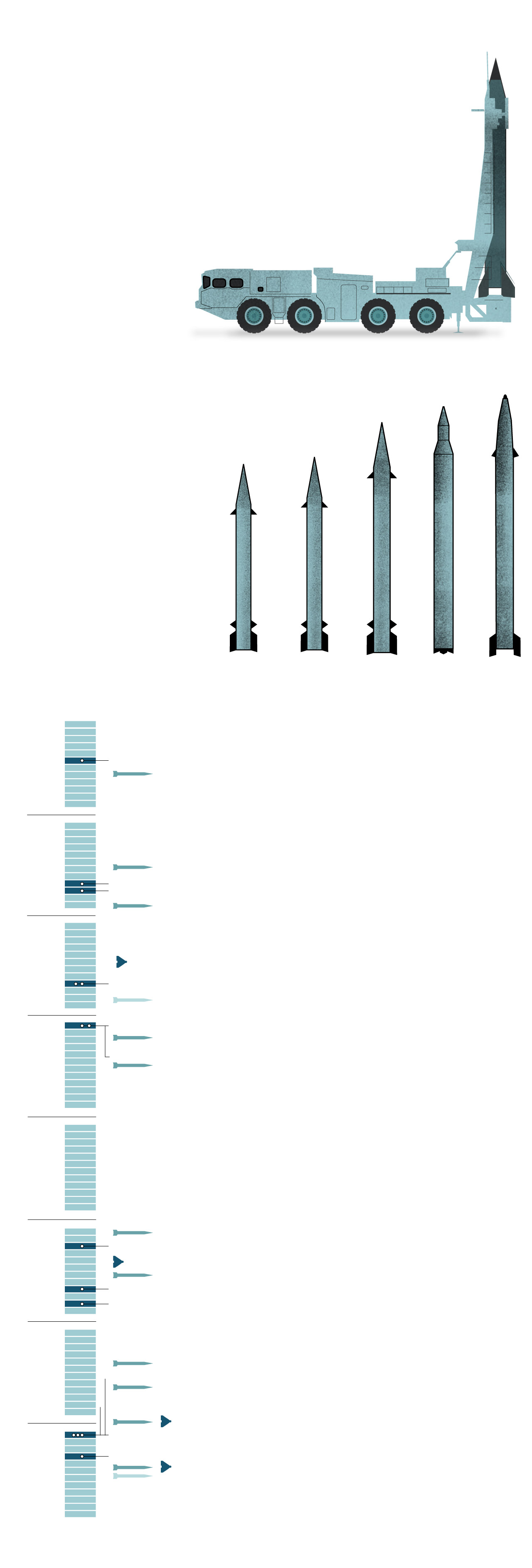
The evolution of Iran’s missile program
Shahab-1
1980s
Scud
1994 to 2001
Iran developed its own version of the Scud B, the Shahab-1, and from 1994 to 2001 fired it at bases in Iraq used by the opposition group Mujahedin-e Khalq.
In the mid-1980s, Tehran acquired Scud missiles from Libya, Syria and North Korea and also began adapting the technology for their own missile variants. During the eight-year war with Iraq, Tehran countered primarily with Scud B missiles, which have a range of 185 miles.
Shahab-1, 186 miles
Since 2017
A new generation of missiles
After 16 years without firing new missiles, Iran showed its technological advances in 2017 striking on an ISIS command center with 6 Zolfaghars with a range of 430 miles. In early 2024, it launched strikes against Islamic State targets in northwest Syria using Kheibar Shekan missiles that travelled 745 miles from Iran to Syria.
Kheibar Shekan, 900 miles
Fahteh 313, 310 miles
Fahteh 110, 181 miles
Zolfaghar, 435 miles
Qiam 1, 497 miles
LOCATION
IRAN TARGETS
KNOWN MISSILE
2017
Against ISIS
Mainly
Zolfaghars
6 ballistic missiles
Deir ez-Zor, Syria
2018
Against Kurdish dissidents
Zolfaghars,
Fateh-110
7 ballistic missiles
Koya, Iraq
Abu Kamal, Syria
Against ISIS
6 ballistic missiles
2019
Against Oil fields and facilities
18 drones + 7 cruise missiles
Abqaiq, Saudi Arabia
Khurais, Saudi Arabia
3 cruise missiles
Against U.S. forces
Erbil, Iraq
1 ballistic missile
2020
Qiams,
Zolfaghars and
potentially
Fateh-313
Ain Al Asad, Iraq
15 to 22 ballistic missiles
2021
Against “Israeli strategic centers”
2022
At least 10 ballistic missiles
Erbil, Iraq
Fateh-110
Against Kurdish dissidents
73 launches + at least 20 drones
Koya, Iraq
Ballistic missiles and suicide drones
Koya, Iraq
Sulaimaniyah, Iraq
2023
Against IS targets
7 ballistic missiles
Harem, Syria
Kheibar Shekan
Israeli “spy headquarters”
7 ballistic missiles
Erbil, Iraq
Against Jaish ul Adl
Balochistan, Pakistan
Missiles and drones against Jaish ul Adl
2024
Against Israel
Israel
120 ballistic missiles,
170 drones, 30 cruise missiles
Sources: United States Institute of Peace, CSIS, IDF
Before the attack on Israel, Iran’s most significant use of ballistic missiles was in 2020, after a U.S. drone attack killed the powerful Iranian commander Qasem Soleimani.
Iran launched more than a dozen ballistic missiles at two U.S. military bases in Iraq, one in the country’s west and one in the north. While there were no fatalities, dozens of U.S. service members suffered traumatic brain injuries.
Iran also used ballistic missiles in strikes this year on Pakistan, Syria and Iraq.
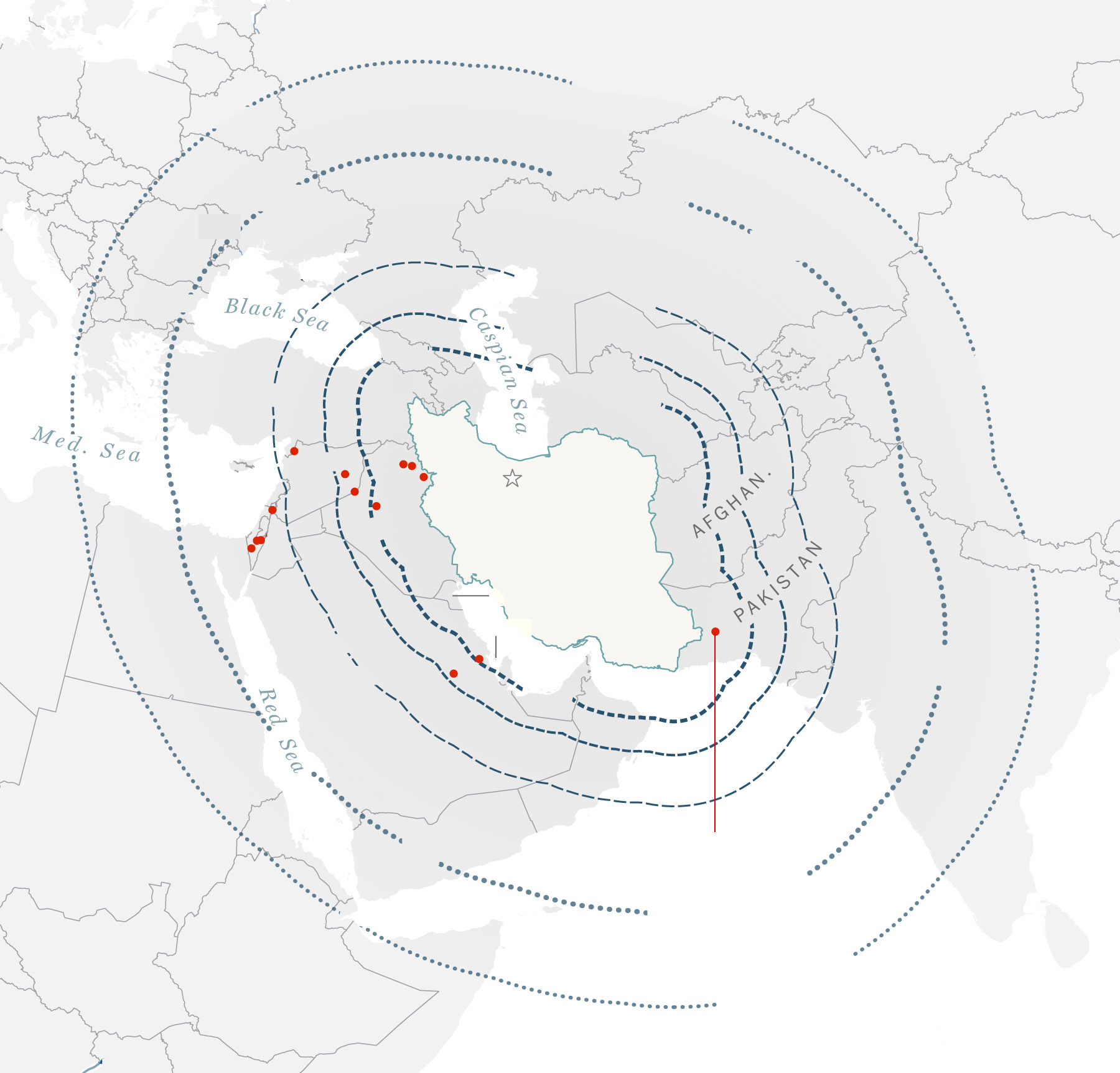
Iranian ballistic
missile ranges
1,240 miles
POLAND
RUSSIA
BELARUS
900 miles
UKRAINE
HUNG.
MOL.
KAZAKHSTAN
ROM.
500 miles
BULG.
300 miles
UZBEK.
KYRGYZ.
GEOR.
GREECE
185 miles
CHINA
ARM.
AZER.
TURKEY
TAJIK.
TURKMEN.
SYRIA
CYPRUS
LEB.
Tehran
ISRAEL
IRAQ
IRAN
NEPAL
JOR.
EGYPT
KUWAIT
BAHRAIN
SAUDI
ARABIA
QATAR
INDIA
U.A.E.
OMAN
SUDAN
ERITREA
YEMEN
Locations of Iranian
missile strikes
since 2017
DJIB.
INDIAN
OCEAN
ETHIOPIA
SOMALIA
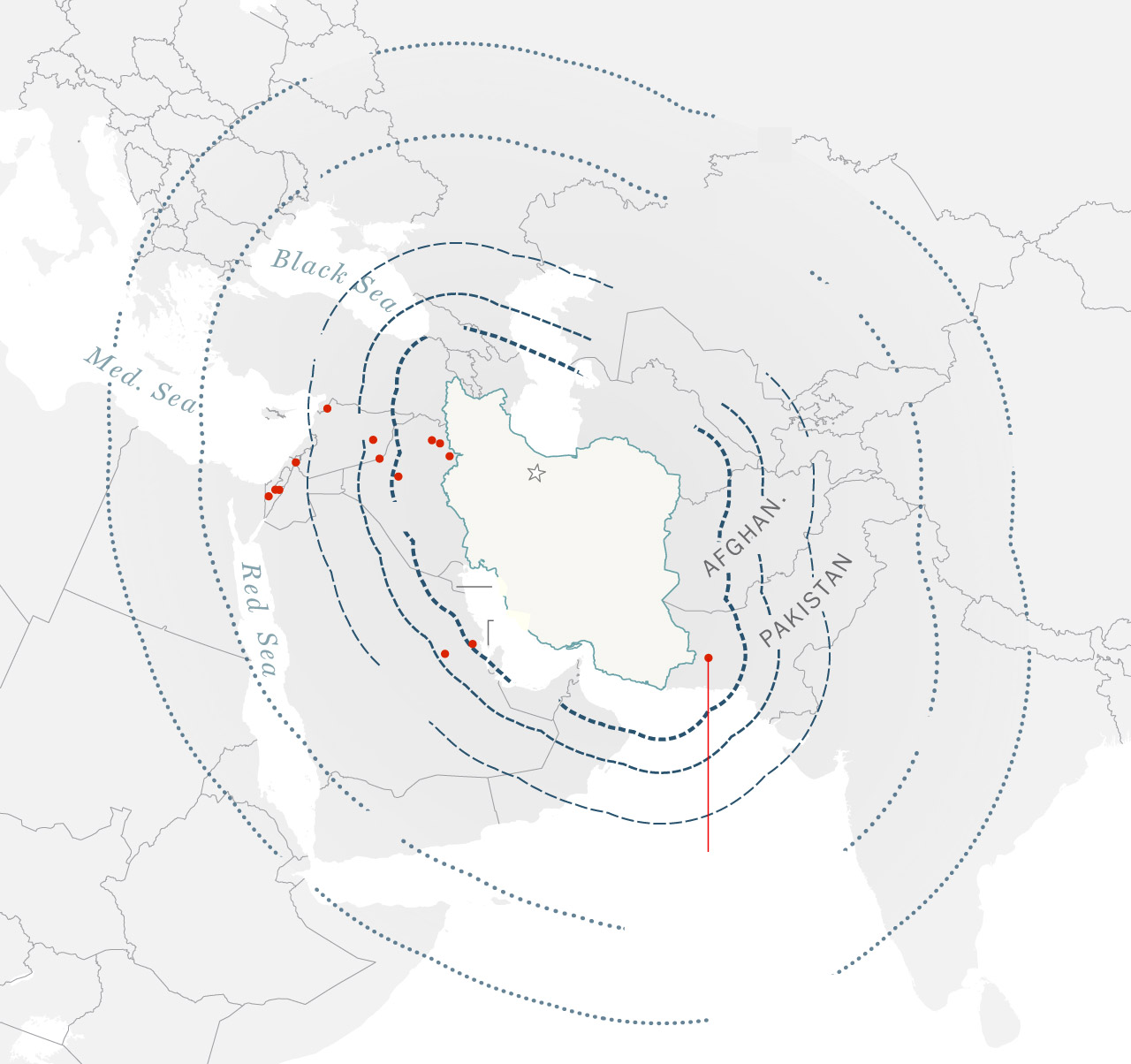
Iranian ballistic
missile ranges
BELARUS
RUSSIA
1,240 miles
UKRAINE
MOL.
ROM.
900 miles
BULG.
500 miles
GREECE
KAZAKHSTAN
GEOR.
300 miles
TURKEY
185 miles
ARM.
UZBEK.
AZER.
KYRGYZ.
TURKMEN.
SYRIA
LEB.
TAJIK.
CHINA
ISRAEL
Tehran
JOR.
IRAQ
EGYPT
IRAN
KUWAIT
NEPAL
BAHRAIN
QATAR
SAUDI
ARABIA
U.A.E.
INDIA
SUDAN
ERITREA
OMAN
YEMEN
Locations of Iranian
missile strikes
since 2017
DJIB.
ETHIOPIA
INDIAN
OCEAN
SOMALIA
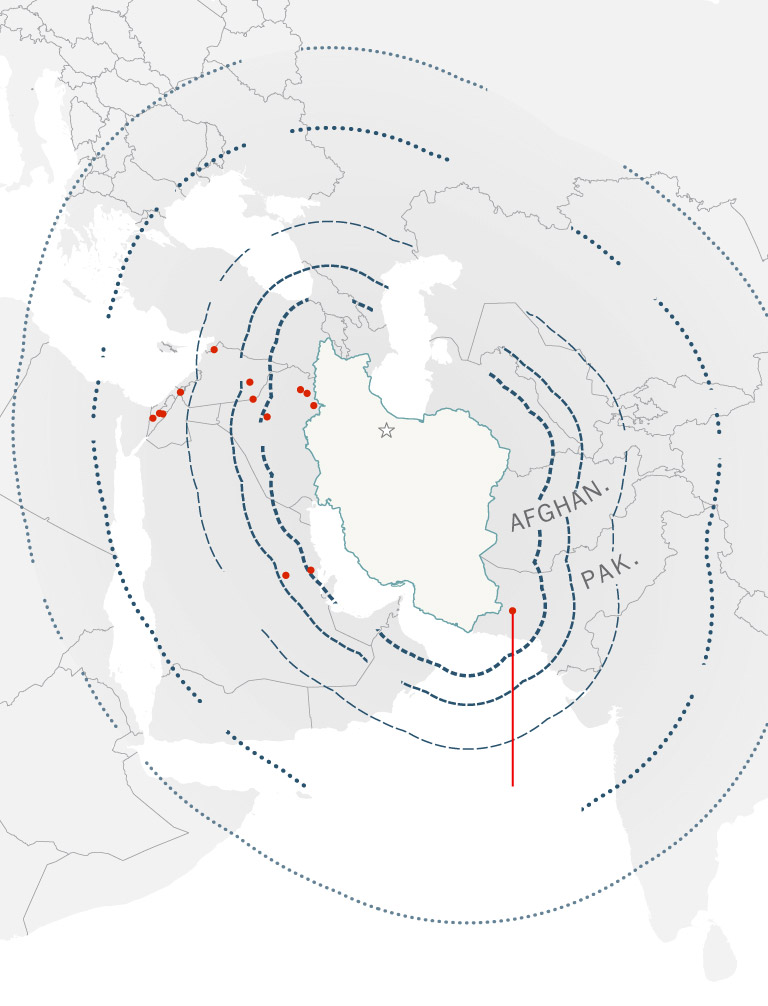
Iranian ballistic
missile ranges
BELARUS
1,240 miles
RUSSIA
UKRAINE
ROM.
900 miles
BULG.
Black
Sea
GREECE
500 miles
KAZAKHSTAN
300 miles
TURKEY
GEO.
Med.
Sea
185 miles
ARM.
AZER.
ISRAEL
UZBEK.
LEB.
SYRIA
TURKMEN.
KYRGYZ.
EGYPT
IRAQ
JOR.
Tehran
TAJIK.
CHINA
Red
Sea
IRAN
SUDAN
SAUDI
ARABIA
U.A.E.
ERITREA
OMAN
INDIA
YEMEN
DJIB.
ETHIOPIA
Locations of Iranian
missile strikes
since 2017
SOMALIA
INDIAN OCEAN

Iranian ballistic
missile ranges
BELARUS
UKRAINE
1,240 miles
RUSSIA
ROM.
900 miles
BULG.
500 miles
KAZAKHSTAN
TURKEY
300 miles
GEO.
185 miles
ARM.
AZER.
UZBEK.
ISRAEL
LEB.
SYRIA
TURKMEN.
IRAQ
JOR.
Tehran
TAJIK.
IRAN
SAUDI
ARABIA
U.A.E.
ERIT.
OMAN
INDIA
YEMEN
DJIB.
Locations of Iranian
missile strikes
since 2017
SOMALIA
INDIAN OCEAN
But the attack on Israel suggests that many of Iran’s munitions are of low quality. Israel’s military said 99 percent of the missiles and drones launched by Iran were intercepted or failed to launch.
“We saw that accuracy and precision are a work in progress,” said Behnam Ben Taleblu, a senior fellow at the Foundation for Defense of Democracies who has written extensively about Iran’s missile program. “These weapons alone won’t win a war for Iran.”
Iranian drones made up the first wave of the attack. Cheap, effective and easy to produce, Iranian drones have been used in attacks across the Middle East for years. Iran has also supplied drones to Russia for its war in Ukraine, where they have been deadly.
During the attack on Israel, the slow-moving drones were probably deployed to occupy air defenses and allow more advanced munitions to get through. All the drones were shot down before entering Israeli airspace, the Israel Defense Forces said.
Ali Hamie, a Lebanese military analyst, said Iran had probably gleaned important lessons about Israel’s aerial defenses. Commentators on Iranian state television have made similar points.
“It could be a testing attack,” Hamie said, “and the Iranians got what they want. Making it past the air defenses is not only a symbolic victory, but real victory.”
One of the few missiles to make it through the interceptors hit an Israeli air base in the Negev desert. Images of the strike were run on loop on many state-run Iranian broadcasters in the days after the attack. Israel characterized the damage as minor.
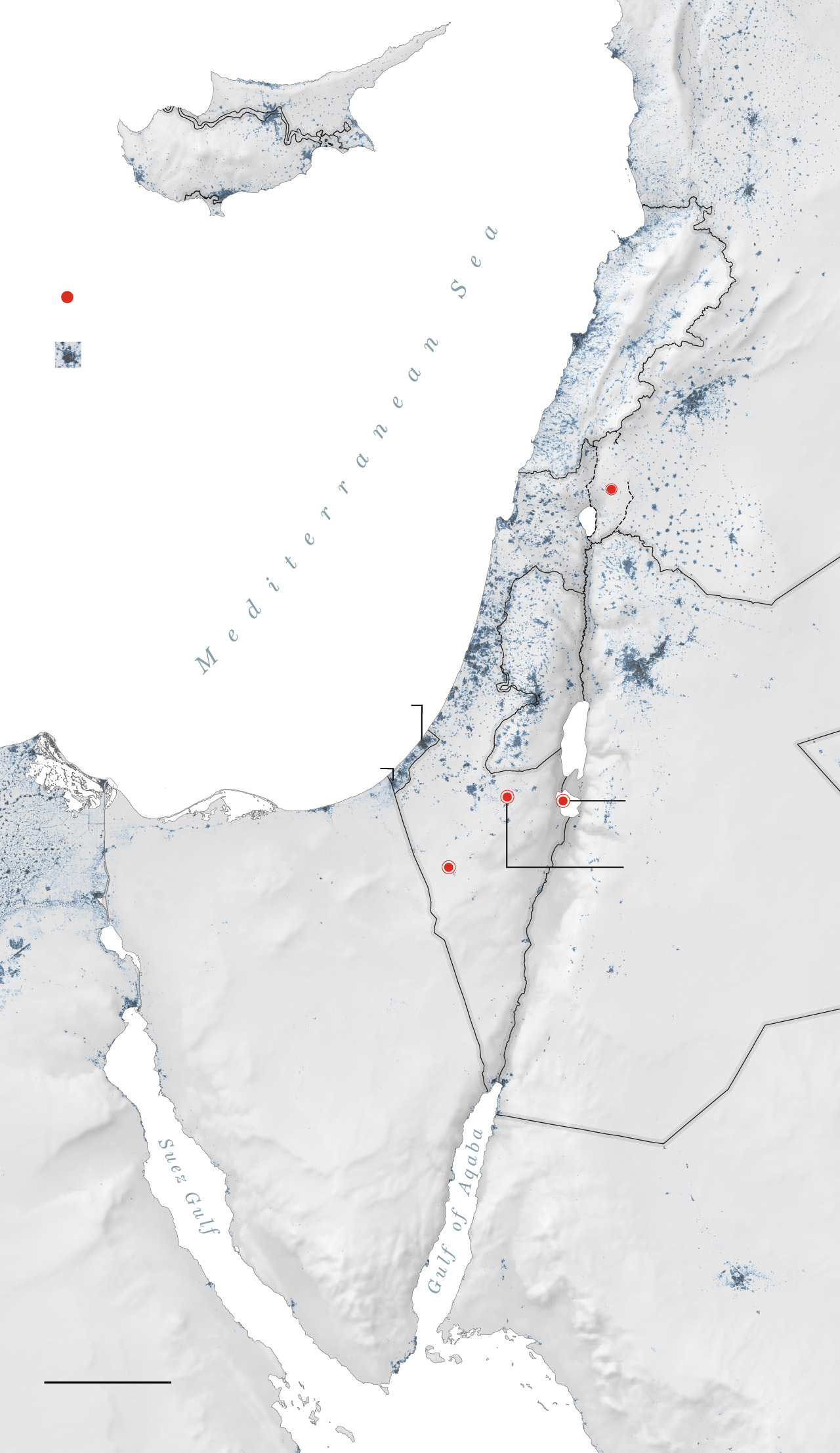
Latakia
SYRIA
CYPRUS
Tartus
Homs
LEBANON
General location of missile strikes
that reached the ground.
Beirut—
Populated areas
Damascus
Golan
Heights
SYRIA
Haifa—
ISRAEL
WEST
BANK
Tel Aviv—
—Amman
Gaza City
—Jerusalem
Dead
Sea
GAZA
Rafah
An emad missile
was found here.
El Arish
The barrage of
missiles from Iran
included targeting
the Nevatim
air base.
Suez
Canal
EGYPT
Suez
JORDAN
Sinai
Peninsula
Aqaba
SAUDI
ARABIA
Tabuk
50 MILES
Red Sea

General location of
missile strikes that
reached the ground.
Populated
areas
LEBANON
Beirut—
Mediterranean
Sea
Damascus
50 MILES
Golan
Heights
SYRIA
Haifa—
ISRAEL
WEST
BANK
Tel Aviv—
—Amman
Gaza
City
Jerusalem
GAZA
Dead
Sea
An emad missile
was found here.
The barrage of
missiles from Iran
included targeting
the Nevatim
air base.
EGYPT
JORDAN
Aqaba

Homs
General location of missile
strikes that reached the
ground.
Populated areas
LEBANON
Beirut—
Mediterranean
Sea
Damascus
50 MILES
Golan
Heights
SYRIA
Haifa—
ISRAEL
WEST
BANK
Tel Aviv—
—Amman
Jerusalem
Gaza City
Dead
Sea
GAZA
Rafah
An emad missile
was found here.
The barrage of
missiles from Iran
included targeting
the Nevatim
air base.
Sinai
Peninsula
EGYPT
JORDAN
Aqaba
In addition to analyzing Israel’s air defenses, Tehran will probably also be studying the problems with its missile systems that reportedly led to failures at launch and in flight, according to Afshon Ostovar, a professor of national security affairs at the Naval Postgraduate School in California.
“Another attack could be more effective,” he said. But ultimately the kind of approach demonstrated in Saturday’s attack “is not really sustainable over a long-term conflict.”
Even if Iran changed the tempo of attacks and adjusted the munitions used, “they would still have to launch quite a lot of stuff for just a few [munitions] to get through,” he said.
Some Iranian officials have suggested they have held back their most dangerous weapons.
“We are prepared to use weapons we have never used before. We have plans for every scenario,” said Abolfazl Amoui, a parliamentary national security spokesman, in an interview with Lebanese broadcaster Mayadeen.
But analysts say it’s unlikely that any one type of munition could be a game changer. Rather, it’s more likely Iran would use the same kinds of munitions in a future attack, but in a different way: giving less warning, or launching the barrage in concert with allied militant groups in the region. The country’s proxy forces, from Lebanon to Iraq to Yemen, played little role in Saturday’s assault.
As Israel mulls its response, Tehran has warned that a counterattack would come in “a matter of seconds.”
“Iran will not wait for another 12 days to respond,” Deputy Foreign Minister Ali Bagheri Kani said Monday.
While the United States and Israel have celebrated the thwarting of Saturday’s attack, analysts are urging humility.
“The number of munitions it took to repel the attack was enormous, costly and could be difficult to replicate,” said Tom Karako, the director of the Missile Defense Project at the Center for Strategic and International Studies.
“Israel may have gotten lucky and Iran may have gotten very unlucky.”
William Neff and Suzan Haidamous contributed to this report.

